-
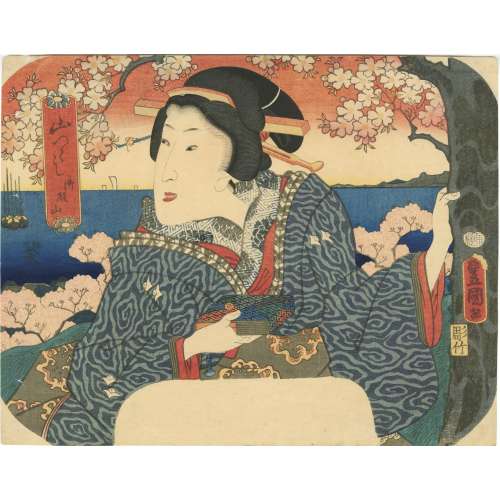 Title: Gotenyama [御殿山] – one of the most popular cherry blossom viewing spots; it is a hill at Shinagawa [品川], the second station on the Tōkaidō road [東海道], located on the shores of Edo Bay [江戸湾]. Series: A Collection of Mountains [山つくし] (Yama tsukushi) Artist: Utagawa Kunisada [歌川 国貞] a.k.a. Utagawa Toyokuni III [三代歌川豊国] (Japanese, 1786 – 12 January 1865). Block carver: Yokokawa Takejirō, seal: [彫竹] – Hori Take. Publisher: Yama-Ta; seal: [板元, 太] – Hanmoto, Ta; Marks 19-044 | U421b: An unknown publisher in Edo, fl. c. 1815-61. Combined date seal and kiwame censor seal: Ansei 6 (1851). Signed: Toyokuni ga [豊国 画] in a red toshidama cartouche. Size: Fan print (uchiwa-e) 227 x 287 mm.
Title: Gotenyama [御殿山] – one of the most popular cherry blossom viewing spots; it is a hill at Shinagawa [品川], the second station on the Tōkaidō road [東海道], located on the shores of Edo Bay [江戸湾]. Series: A Collection of Mountains [山つくし] (Yama tsukushi) Artist: Utagawa Kunisada [歌川 国貞] a.k.a. Utagawa Toyokuni III [三代歌川豊国] (Japanese, 1786 – 12 January 1865). Block carver: Yokokawa Takejirō, seal: [彫竹] – Hori Take. Publisher: Yama-Ta; seal: [板元, 太] – Hanmoto, Ta; Marks 19-044 | U421b: An unknown publisher in Edo, fl. c. 1815-61. Combined date seal and kiwame censor seal: Ansei 6 (1851). Signed: Toyokuni ga [豊国 画] in a red toshidama cartouche. Size: Fan print (uchiwa-e) 227 x 287 mm. -
 Artist: Utagawa Kuniyasu [歌川 国安] (Japanese, 1794–1832). Publisher seal: [太] (Ta): Marks 02-050 | U421b: An unknown publisher in Edo, fl. c. 1815-61; name assigned according to seal shape “Yama-Ta“. Signed: Kuniyasu ga [国安 画]. Date-aratame seal: Bunsei 9 (1826). Actors: Iwai Hanshirō VI [岩井半四郎] (Japanese, 1799 – 1836), other names: Iwai Hanshirō VI, Iwai Kumesaburō II, Iwai Hisajirō I, Baiga (poetry name), Shūka (poetry name) — as Shirai Gonpachi [白井權八]. Ichikawa Danjūrō VII 市川団十郎 (Japanese, 1791 – 1859), other names: Ichikawa Ebizō V, Ichikawa Hakuen II, Ichikawa Shinnosuke I — as Banzui Chōbei [幡随長兵衛]. Kabuki play: Suzugamori [Suzu-ga-Mori, 鈴ヶ森], a.k.a. Ukiyozuka Hiyoku no Inazuma written by Tsuruya Nanboku IV (Japanese, c. 1755 – 1829). First staged in 1823 at Ichimura-za [市村座] in Edo. Plot: "A gang of evil palanquin bearers are stationed near the Suzugamori execution grounds, where they lay in wait to rob travellers passing through. Gonpachi, who killed a man in his home province, is being sought by the police. He is fleeing to Edo when the bearers attack him in hopes of claiming a reward. He beats them off with great skill. Banzui Chōbei, who is being carried by in a palanquin, sees the attack, admires Gonpachi's ability, and promises to aid him if he is going to Edo". [Samuel L. Leiter. Historical Dictionary of Japanese Traditional Theatre. — Rowman & Littlefield, 2014; p. 382-3.; LIB-2110.2019]. Ref.: Sotheby's.
Artist: Utagawa Kuniyasu [歌川 国安] (Japanese, 1794–1832). Publisher seal: [太] (Ta): Marks 02-050 | U421b: An unknown publisher in Edo, fl. c. 1815-61; name assigned according to seal shape “Yama-Ta“. Signed: Kuniyasu ga [国安 画]. Date-aratame seal: Bunsei 9 (1826). Actors: Iwai Hanshirō VI [岩井半四郎] (Japanese, 1799 – 1836), other names: Iwai Hanshirō VI, Iwai Kumesaburō II, Iwai Hisajirō I, Baiga (poetry name), Shūka (poetry name) — as Shirai Gonpachi [白井權八]. Ichikawa Danjūrō VII 市川団十郎 (Japanese, 1791 – 1859), other names: Ichikawa Ebizō V, Ichikawa Hakuen II, Ichikawa Shinnosuke I — as Banzui Chōbei [幡随長兵衛]. Kabuki play: Suzugamori [Suzu-ga-Mori, 鈴ヶ森], a.k.a. Ukiyozuka Hiyoku no Inazuma written by Tsuruya Nanboku IV (Japanese, c. 1755 – 1829). First staged in 1823 at Ichimura-za [市村座] in Edo. Plot: "A gang of evil palanquin bearers are stationed near the Suzugamori execution grounds, where they lay in wait to rob travellers passing through. Gonpachi, who killed a man in his home province, is being sought by the police. He is fleeing to Edo when the bearers attack him in hopes of claiming a reward. He beats them off with great skill. Banzui Chōbei, who is being carried by in a palanquin, sees the attack, admires Gonpachi's ability, and promises to aid him if he is going to Edo". [Samuel L. Leiter. Historical Dictionary of Japanese Traditional Theatre. — Rowman & Littlefield, 2014; p. 382-3.; LIB-2110.2019]. Ref.: Sotheby's. -
 Series: Pictures Associated with the Iroha Syllabary [伊呂波画合]. Artist: Utagawa Kuniyoshi [歌川 國芳] (1798 – 1861). Signed: Ichiyûsai Kuniyoshi giga [一勇斎 國芳戯画] (Playfully drawn by Ichiyūsai Kuniyoshi) in a red double-gourd cartouche with a kiri-mon seal beneath. Publisher: Iseya Ichiemon [伊勢屋市右衛門] (Japanese, fl. 1823 – c. 1864); seal [辻] (Marks 16-029 | 143a). Single nanushi censor seal: Mura [村] = Murata Sahei [村田佐右衛] (VI/1842 – V/1846). Media: Fan print (uchiwa-e, 団扇絵), 231 x 296 mm. Theme: The Treasury of Loyal Retainers [仮名手本忠臣蔵] (Kanadehon Chūshingura) – an 11-act puppet play composed in 1748, based on a historical event. "Most historians now agree that there were forty-seven rōnin of Ako who attacked and killed Kira Yoshinaka (吉良 義央, 1641 – 1703) in Edo in the twelfth month of 1702, twenty-two months after their lord Asano Naganori (浅野 長矩, 1667 – 1701) had been put to death for his own failed attempt on Kira’s life". [Henry D. SMITH II. The Trouble with Terasaka: The Forty-Seventh Rōnin and the Chūshingura Imagination / Japan Review, 2004, 16:3-65]. The reader shall remember that the fictional, romantic version of the Akō incident [赤穂事件] (Akō jiken) may not (and most probably does not) reflect the historical truth of events. Uncut fan print depicting a beautiful young woman covering another woman's mouth with a blue striped cloth, possibly an obi. The picture on the wall represents the scene from the final act of The Treasury of Loyal Retainers (Kanadehon Chūshingura, Act 11) when 47 loyal retainers (rōnin) of the late lord En'ya Hangan came to the house of Kō no Moronao in order to avenge their dead master. The leader of 47 rōnin, Ōboshi Yuranosuke, divided his accomplices into several groups which attacked the Moronao mansion from different directions. To coordinate the attack and keep communication among the groups, the rōnin were signing the first syllables of their names in the hiragana syllabary. There are two major types of the ordering of the hiragana syllabary, the Gojūon one and the Iroha order (pangram poem), the latter being used here. The number of avengers exactly matches the 47 letters of that syllabary. The group entering Moronao's house from the front gate was 'chi-ri-nu-ru-wo-wa-ka'. Yoshida Sadaemon Kanesada [葦田貞右衛門兼貞] (1675 – 1703) depicted on this fan print belongs to this group. The character on the lantern hanging from Yoshida's spear reads Chū [忠] – for Chūshingura. Alternating black and white triangles on the picture frame allude to the 'signature' 47 ronin's uniform. This motif is usually described as a zigzag pattern [雁木模様] (gangi moyō), a mountain-shaped pattern [山形模様] (yamagata moyō), or a mountain road [山道] (yamamichi). The rōnin were allegedly wearing this uniform in imitation of firefighters. The government allowed the firefighters alone to gather in large groups and carry equipment akin to that of the military. Such equipment was necessary for firemen to tear down the burning buildings to stop the flames. The design can be seen in Kunimaru's fan print [SVJP-0233.2018] in this collection.Fighting Moronao's guards, the 47 rōnin entered the mansion and searched for their enemy but in vain. Finally, Yazama Jujiro Motooki [矢間重次郎元興] found the villain in the charcoal chamber and called his friends. This is the exact moment we see in the picture on the wall: Yoshida entering the charcoal chamber with a spear in his hand amid falling baskets and charcoal. Kō no Moronao was brought to justice and beheaded; his head was offered before the memorial tablet of En'ya Hangan to appease his spirit. After that, Ōboshi Yuranosuke and his 46 friends committed seppuku. They were buried at Sengakuji (泉岳寺) – a small temple near Shinagawa in Edo (Tokyo).
Series: Pictures Associated with the Iroha Syllabary [伊呂波画合]. Artist: Utagawa Kuniyoshi [歌川 國芳] (1798 – 1861). Signed: Ichiyûsai Kuniyoshi giga [一勇斎 國芳戯画] (Playfully drawn by Ichiyūsai Kuniyoshi) in a red double-gourd cartouche with a kiri-mon seal beneath. Publisher: Iseya Ichiemon [伊勢屋市右衛門] (Japanese, fl. 1823 – c. 1864); seal [辻] (Marks 16-029 | 143a). Single nanushi censor seal: Mura [村] = Murata Sahei [村田佐右衛] (VI/1842 – V/1846). Media: Fan print (uchiwa-e, 団扇絵), 231 x 296 mm. Theme: The Treasury of Loyal Retainers [仮名手本忠臣蔵] (Kanadehon Chūshingura) – an 11-act puppet play composed in 1748, based on a historical event. "Most historians now agree that there were forty-seven rōnin of Ako who attacked and killed Kira Yoshinaka (吉良 義央, 1641 – 1703) in Edo in the twelfth month of 1702, twenty-two months after their lord Asano Naganori (浅野 長矩, 1667 – 1701) had been put to death for his own failed attempt on Kira’s life". [Henry D. SMITH II. The Trouble with Terasaka: The Forty-Seventh Rōnin and the Chūshingura Imagination / Japan Review, 2004, 16:3-65]. The reader shall remember that the fictional, romantic version of the Akō incident [赤穂事件] (Akō jiken) may not (and most probably does not) reflect the historical truth of events. Uncut fan print depicting a beautiful young woman covering another woman's mouth with a blue striped cloth, possibly an obi. The picture on the wall represents the scene from the final act of The Treasury of Loyal Retainers (Kanadehon Chūshingura, Act 11) when 47 loyal retainers (rōnin) of the late lord En'ya Hangan came to the house of Kō no Moronao in order to avenge their dead master. The leader of 47 rōnin, Ōboshi Yuranosuke, divided his accomplices into several groups which attacked the Moronao mansion from different directions. To coordinate the attack and keep communication among the groups, the rōnin were signing the first syllables of their names in the hiragana syllabary. There are two major types of the ordering of the hiragana syllabary, the Gojūon one and the Iroha order (pangram poem), the latter being used here. The number of avengers exactly matches the 47 letters of that syllabary. The group entering Moronao's house from the front gate was 'chi-ri-nu-ru-wo-wa-ka'. Yoshida Sadaemon Kanesada [葦田貞右衛門兼貞] (1675 – 1703) depicted on this fan print belongs to this group. The character on the lantern hanging from Yoshida's spear reads Chū [忠] – for Chūshingura. Alternating black and white triangles on the picture frame allude to the 'signature' 47 ronin's uniform. This motif is usually described as a zigzag pattern [雁木模様] (gangi moyō), a mountain-shaped pattern [山形模様] (yamagata moyō), or a mountain road [山道] (yamamichi). The rōnin were allegedly wearing this uniform in imitation of firefighters. The government allowed the firefighters alone to gather in large groups and carry equipment akin to that of the military. Such equipment was necessary for firemen to tear down the burning buildings to stop the flames. The design can be seen in Kunimaru's fan print [SVJP-0233.2018] in this collection.Fighting Moronao's guards, the 47 rōnin entered the mansion and searched for their enemy but in vain. Finally, Yazama Jujiro Motooki [矢間重次郎元興] found the villain in the charcoal chamber and called his friends. This is the exact moment we see in the picture on the wall: Yoshida entering the charcoal chamber with a spear in his hand amid falling baskets and charcoal. Kō no Moronao was brought to justice and beheaded; his head was offered before the memorial tablet of En'ya Hangan to appease his spirit. After that, Ōboshi Yuranosuke and his 46 friends committed seppuku. They were buried at Sengakuji (泉岳寺) – a small temple near Shinagawa in Edo (Tokyo).
Utagawa Kunimaru. Chūshingura, Act 11.
 Another fan print from the same series can be found at Kuniyoshi Project:
Another fan print from the same series can be found at Kuniyoshi Project:
 The same subject is portrayed by Kuniyoshi in the series Mirror of the True Loyalty of the Faithful Retainers [誠忠義臣鏡] (Seichû gishin kagami), publisher: Kagiya Hanjirô, c. 1851 (Kuniyoshi Project) – Yoshida Sadaemon Kanesada (葦田貞右衛門兼貞) raising his sword amid falling baskets and charcoal:
The same subject is portrayed by Kuniyoshi in the series Mirror of the True Loyalty of the Faithful Retainers [誠忠義臣鏡] (Seichû gishin kagami), publisher: Kagiya Hanjirô, c. 1851 (Kuniyoshi Project) – Yoshida Sadaemon Kanesada (葦田貞右衛門兼貞) raising his sword amid falling baskets and charcoal:

-
 Artist: Utagawa Sadahide [歌川貞秀] (Japanese, 1807 – 1879) Publisher: Kojimaya Jūbei [小島屋重兵衛] (Japanese, c. 1797 – 1869) No date seal, no censor seal (privately printed?) Media: Fan print (uchiwa-e, 団扇絵), 235 x 297 mm. Kalimeris incisa, or Japanese Aster, is a daisy-like flower that belongs to the family of Asteraceae; it blossoms all summer and attracts butterflies. Peony [牡丹] (botan) – per Merrily Baird it is "the king of flowers", associated with erotic love, and especially with the sexual activities of women.
Artist: Utagawa Sadahide [歌川貞秀] (Japanese, 1807 – 1879) Publisher: Kojimaya Jūbei [小島屋重兵衛] (Japanese, c. 1797 – 1869) No date seal, no censor seal (privately printed?) Media: Fan print (uchiwa-e, 団扇絵), 235 x 297 mm. Kalimeris incisa, or Japanese Aster, is a daisy-like flower that belongs to the family of Asteraceae; it blossoms all summer and attracts butterflies. Peony [牡丹] (botan) – per Merrily Baird it is "the king of flowers", associated with erotic love, and especially with the sexual activities of women. -
 An uncut fan print showing Otsu-e [大津絵] (Otsu pictures). Artist: Utagawa Sadahide [歌川貞秀] (Japanese, 1807 – 1879). Signed: Gountei Sadahide ga [五雲亭貞秀画] (Picture by Gountei Sadahide); characters on the Otsu-e. Publisher: Ibaya Senzaburō [伊場屋仙三郎] (Japanese, c. 1815 – 1869). Published: c. 1849. Inscription in a paper-weight shaped cartouche: [大津追 分絵の図] Ōtsu-oi wake-e no zu (Following Otsu – image of separate pictures) No date seal, no censor seal (privately printed?) Media: Fan print (uchiwa-e, 団扇絵), 235 x 298 mm.
An uncut fan print showing Otsu-e [大津絵] (Otsu pictures). Artist: Utagawa Sadahide [歌川貞秀] (Japanese, 1807 – 1879). Signed: Gountei Sadahide ga [五雲亭貞秀画] (Picture by Gountei Sadahide); characters on the Otsu-e. Publisher: Ibaya Senzaburō [伊場屋仙三郎] (Japanese, c. 1815 – 1869). Published: c. 1849. Inscription in a paper-weight shaped cartouche: [大津追 分絵の図] Ōtsu-oi wake-e no zu (Following Otsu – image of separate pictures) No date seal, no censor seal (privately printed?) Media: Fan print (uchiwa-e, 団扇絵), 235 x 298 mm. -
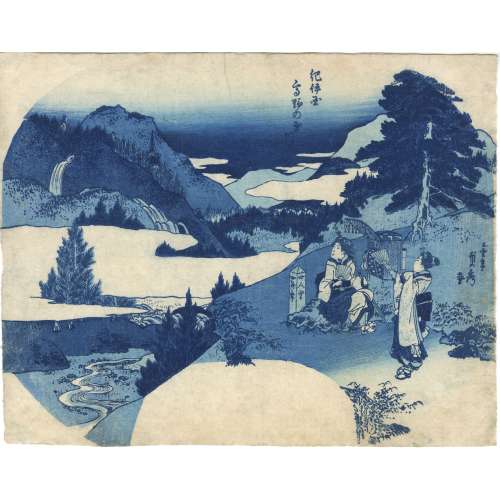 An uncut aizuri fan print showing two travellers admiring the view of the Tama River [多摩川] (Tamagawa) and Mount Kōya [高野山] (Kōyasan) in Kii Province [紀伊国] (Kii no Kuni). Artist: Utagawa Sadahide [歌川貞秀] (Japanese, 1807 – 1879). Signed: Gountei Sadahide ga [五雲亭貞秀画] (Picture by Gountei Sadahide). Publisher: Unknown. Published: c. 1849. No date seal, no censor seal (privately printed?) Media: Fan print [団扇絵] (uchiwa-e), 235 x 300 mm.
An uncut aizuri fan print showing two travellers admiring the view of the Tama River [多摩川] (Tamagawa) and Mount Kōya [高野山] (Kōyasan) in Kii Province [紀伊国] (Kii no Kuni). Artist: Utagawa Sadahide [歌川貞秀] (Japanese, 1807 – 1879). Signed: Gountei Sadahide ga [五雲亭貞秀画] (Picture by Gountei Sadahide). Publisher: Unknown. Published: c. 1849. No date seal, no censor seal (privately printed?) Media: Fan print [団扇絵] (uchiwa-e), 235 x 300 mm. -
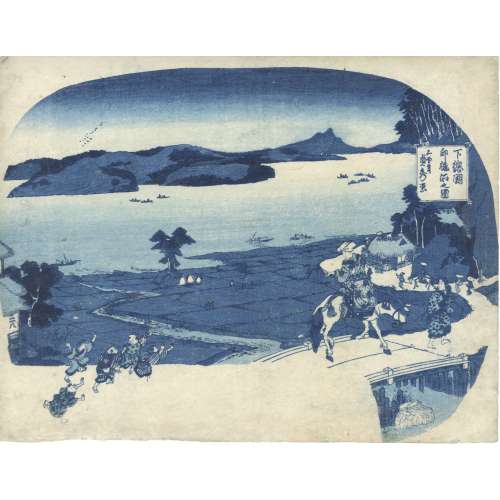 An uncut aizuri fan print showing travellers arriving at Inba Lake [印旛沼] (Inba-numa) on Shimosa Plateau [下総台地] (Shimōsa-daichi). Artist: Utagawa Sadahide [歌川貞秀] (Japanese, 1807 – 1879) Publisher: Unknown. Published: c. 1849. Signed: Gountei Sadahide ga [五雲亭 貞秀画] (Picture by Gountei Sadahide). Inscription in cartouche: Shimosa Plateau, Inbanuma (Inba Lake) [下總國印幡沼]. No date seal, no censor seal (privately printed?) Media: Fan print [団扇絵] (uchiwa-e), 235 x 300 mm.
An uncut aizuri fan print showing travellers arriving at Inba Lake [印旛沼] (Inba-numa) on Shimosa Plateau [下総台地] (Shimōsa-daichi). Artist: Utagawa Sadahide [歌川貞秀] (Japanese, 1807 – 1879) Publisher: Unknown. Published: c. 1849. Signed: Gountei Sadahide ga [五雲亭 貞秀画] (Picture by Gountei Sadahide). Inscription in cartouche: Shimosa Plateau, Inbanuma (Inba Lake) [下總國印幡沼]. No date seal, no censor seal (privately printed?) Media: Fan print [団扇絵] (uchiwa-e), 235 x 300 mm. -
 Title: Early Spring [初春之図] (Hatsuharu no zu); Series: Fashionable Twelve Months [今様十二ヶ月] (Imayo juni-kagetsu). Another version of translation: Modern Beauties of Twelve Months. Artist: Utagawa Toyokuni I [歌川豊国] (1769–1825). Pubisher: Ibaya Senzaburō [伊場屋仙三郎] (Japanese, 1815 – 1869), seal: Dansendō [伊場仙]. Signed: Toyokuni ga [豊国画] and sealed with toshidama. Date-kiwame seal: Ushi (ox), Bunsei 5 (1822). Size: double-sheet uncut fan print ( aiban uchiwa-e), each 217 x 288 mm. Ref: Tokyo Museum Collection.
Title: Early Spring [初春之図] (Hatsuharu no zu); Series: Fashionable Twelve Months [今様十二ヶ月] (Imayo juni-kagetsu). Another version of translation: Modern Beauties of Twelve Months. Artist: Utagawa Toyokuni I [歌川豊国] (1769–1825). Pubisher: Ibaya Senzaburō [伊場屋仙三郎] (Japanese, 1815 – 1869), seal: Dansendō [伊場仙]. Signed: Toyokuni ga [豊国画] and sealed with toshidama. Date-kiwame seal: Ushi (ox), Bunsei 5 (1822). Size: double-sheet uncut fan print ( aiban uchiwa-e), each 217 x 288 mm. Ref: Tokyo Museum Collection.
Other five prints of this series: SVJP 0326.2020; SVJP-0362.2022; SVJP-0363.2022; SVJP-0364.2022; SVJP-0365.2022.

-
 Title: Fourth lunar month [卯月] (Uzuki no zu); Series: Fashionable Twelve Months (Imayo juni-kagetsu). Another version of translation: Modern Beauties of Twelve Months. Artist: Utagawa Toyokuni I [歌川豊国] (1769–1825). Pubisher: Ibaya Senzaburō [伊場屋仙三郎] (Japanese, 1815 – 1869), seal: Dansendō [伊場仙]. Signed: Toyokuni ga and sealed with toshidama. Date-kiwame seal: Ushi (ox), Bunsei 5 (1822). Size: double-sheet uncut fan print ( aiban uchiwa-e), 219 x 295 mm.
Title: Fourth lunar month [卯月] (Uzuki no zu); Series: Fashionable Twelve Months (Imayo juni-kagetsu). Another version of translation: Modern Beauties of Twelve Months. Artist: Utagawa Toyokuni I [歌川豊国] (1769–1825). Pubisher: Ibaya Senzaburō [伊場屋仙三郎] (Japanese, 1815 – 1869), seal: Dansendō [伊場仙]. Signed: Toyokuni ga and sealed with toshidama. Date-kiwame seal: Ushi (ox), Bunsei 5 (1822). Size: double-sheet uncut fan print ( aiban uchiwa-e), 219 x 295 mm.

-
 Title: Ninth lunar month [菊月] (Kikuzuki no zu); Series: Fashionable Twelve Months (Imayo juni-kagetsu). Another version of translation: Modern Beauties of Twelve Months. Artist: Utagawa Toyokuni I [歌川豊国] (1769–1825). Pubisher: Ibaya Senzaburō [伊場屋仙三郎] (Japanese, 1815 – 1869), seal: Dansendō [伊場仙]. Signed: Toyokuni ga and sealed with toshidama. Date-kiwame seal: Ushi (ox), Bunsei 5 (1822). Size: double-sheet uncut fan print ( aiban uchiwa-e), 219 x 295 mm.
Title: Ninth lunar month [菊月] (Kikuzuki no zu); Series: Fashionable Twelve Months (Imayo juni-kagetsu). Another version of translation: Modern Beauties of Twelve Months. Artist: Utagawa Toyokuni I [歌川豊国] (1769–1825). Pubisher: Ibaya Senzaburō [伊場屋仙三郎] (Japanese, 1815 – 1869), seal: Dansendō [伊場仙]. Signed: Toyokuni ga and sealed with toshidama. Date-kiwame seal: Ushi (ox), Bunsei 5 (1822). Size: double-sheet uncut fan print ( aiban uchiwa-e), 219 x 295 mm.

-
 Title: Seventh lunar month [初秋] (Hatsuaki no zu); Series: Fashionable Twelve Months (Imayo juni-kagetsu). Another version of translation: Modern Beauties of Twelve Months. Artist: Utagawa Toyokuni I [歌川豊国] (1769–1825). Pubisher: Ibaya Senzaburō [伊場屋仙三郎] (Japanese, 1815 – 1869), seal: Dansendō [伊場仙]. Signed: Toyokuni ga and sealed with toshidama. Date-kiwame seal: Ushi (ox), Bunsei 5 (1822). Size: double-sheet uncut fan print ( aiban uchiwa-e), 219 x 295 mm.
Title: Seventh lunar month [初秋] (Hatsuaki no zu); Series: Fashionable Twelve Months (Imayo juni-kagetsu). Another version of translation: Modern Beauties of Twelve Months. Artist: Utagawa Toyokuni I [歌川豊国] (1769–1825). Pubisher: Ibaya Senzaburō [伊場屋仙三郎] (Japanese, 1815 – 1869), seal: Dansendō [伊場仙]. Signed: Toyokuni ga and sealed with toshidama. Date-kiwame seal: Ushi (ox), Bunsei 5 (1822). Size: double-sheet uncut fan print ( aiban uchiwa-e), 219 x 295 mm.

-
 Title: Third lunar month [弥生] (Yayoi no zu); Series: Fashionable Twelve Months (Imayo juni-kagetsu). Another version of translation: Modern Beauties of Twelve Months. Artist: Utagawa Toyokuni I [歌川豊国] (1769–1825). Pubisher: Ibaya Senzaburō [伊場屋仙三郎] (Japanese, 1815 – 1869), seal: Dansendō [伊場仙]. Signed: Toyokuni ga and sealed with toshidama. Date-kiwame seal: Ushi (ox), Bunsei 5 (1822). Size: double-sheet uncut fan print ( aiban uchiwa-e), 219 x 295 mm.
Title: Third lunar month [弥生] (Yayoi no zu); Series: Fashionable Twelve Months (Imayo juni-kagetsu). Another version of translation: Modern Beauties of Twelve Months. Artist: Utagawa Toyokuni I [歌川豊国] (1769–1825). Pubisher: Ibaya Senzaburō [伊場屋仙三郎] (Japanese, 1815 – 1869), seal: Dansendō [伊場仙]. Signed: Toyokuni ga and sealed with toshidama. Date-kiwame seal: Ushi (ox), Bunsei 5 (1822). Size: double-sheet uncut fan print ( aiban uchiwa-e), 219 x 295 mm.

-
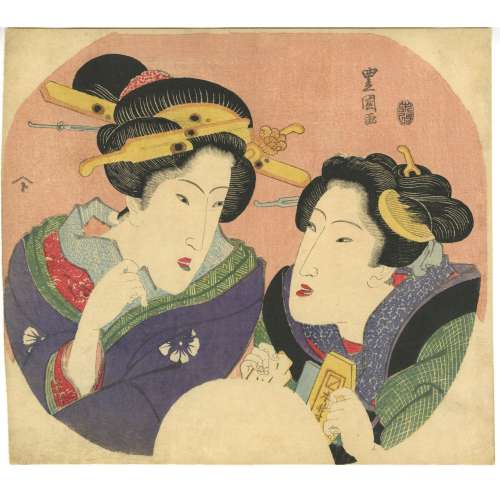 Artist: Utagawa Toyokuni I [歌川豊国] (1769–1825). Pubisher: Enshūya Matabei (遠州屋又兵衛) (c. 1768 – 1881), seal name: Enmata [ 遠又]. Signed: Toyokuni ga [豊国画]. Date-aratame censor seal: 未改, Bunsei 6 (1823). Size: uchiwa-e; 233 x 262 mm. Ref: Israel Goldman. Japanese Prints, Paintings and Books / Catalogue 28, 2022: № 14.
Artist: Utagawa Toyokuni I [歌川豊国] (1769–1825). Pubisher: Enshūya Matabei (遠州屋又兵衛) (c. 1768 – 1881), seal name: Enmata [ 遠又]. Signed: Toyokuni ga [豊国画]. Date-aratame censor seal: 未改, Bunsei 6 (1823). Size: uchiwa-e; 233 x 262 mm. Ref: Israel Goldman. Japanese Prints, Paintings and Books / Catalogue 28, 2022: № 14. -
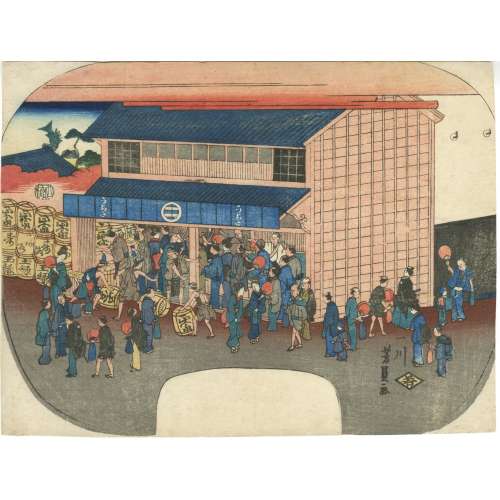 Artist: Utagawa Yoshikazu [歌川芳員] (Japanese, fl. c. 1850 – 1870). Publisher: Wakasaya Yoichi [若狭屋与市] (Japanese, fl. 1794 – 1897). Combined date seal and kiwame censor seal: 1861 (Man'en 2 / Bunkyū 1, from 19/02).
Artist: Utagawa Yoshikazu [歌川芳員] (Japanese, fl. c. 1850 – 1870). Publisher: Wakasaya Yoichi [若狭屋与市] (Japanese, fl. 1794 – 1897). Combined date seal and kiwame censor seal: 1861 (Man'en 2 / Bunkyū 1, from 19/02). -
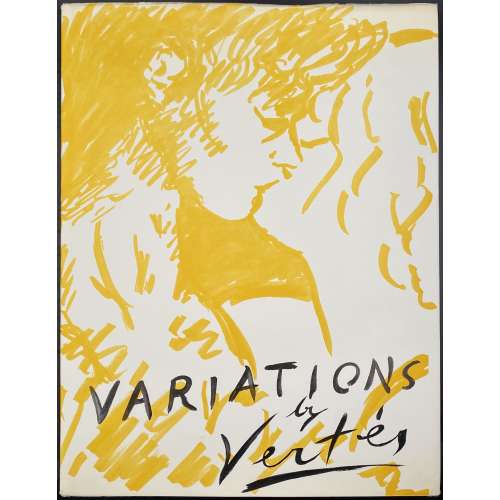 Hardcover volume, 33 x 25.5 cm, bound in grey cloth, vignette and Vertès signature fac-simile to front cover, unclipped ($ 17.50) pictorial dust jacket with black lettering, polyester jacket cover, pp.: [2] [1-4] 5-150 [2], 77 leaves total, ils. Title-page: VARIATIONS | Drawings, water colors, etchings and lithographs | by | VERTÈS | Text by | CLAUDE ROGER-MARX | { publisher’s device} | NEW YORK GRAPHIC SOCIETY | GREENWICH, CONNECTICUT || Limitation: edition of 1,000 copies, of which 5 copies (A-E) were enriched with one original drawing; 100 copies (1-100) were enriched with one original signed lithograph; and 895 copies (101-1000). This is copy № 984. Contributors: Roger-Marx, Claude (Jewish-French, 1888 – 1977) – author. Vertès, Marcel [Vértes, Marcell] (Jewish-Hungarian-French, 1895 – 1961) – artist
Hardcover volume, 33 x 25.5 cm, bound in grey cloth, vignette and Vertès signature fac-simile to front cover, unclipped ($ 17.50) pictorial dust jacket with black lettering, polyester jacket cover, pp.: [2] [1-4] 5-150 [2], 77 leaves total, ils. Title-page: VARIATIONS | Drawings, water colors, etchings and lithographs | by | VERTÈS | Text by | CLAUDE ROGER-MARX | { publisher’s device} | NEW YORK GRAPHIC SOCIETY | GREENWICH, CONNECTICUT || Limitation: edition of 1,000 copies, of which 5 copies (A-E) were enriched with one original drawing; 100 copies (1-100) were enriched with one original signed lithograph; and 895 copies (101-1000). This is copy № 984. Contributors: Roger-Marx, Claude (Jewish-French, 1888 – 1977) – author. Vertès, Marcel [Vértes, Marcell] (Jewish-Hungarian-French, 1895 – 1961) – artist -
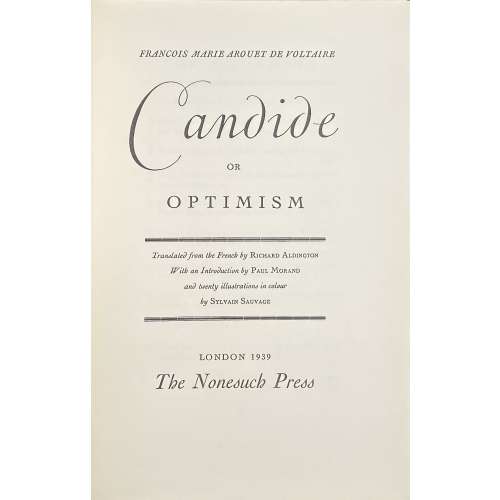 Description: Quarter red buckram over paper boards with fleur-de-lis diaper, 25.9 x 17.2 cm, gilt lettering to spine, in a cardboard slipcase, bookplate to front pastedown “EX LIBRIS | William Farrell Smith || Title-page: FRANÇOIS MARIE AROUET DE VOLTAIRE | Candide | OR | OPTIMISM | — | Translated from the French by Richard Aldington | With an Introduction by Paul Morand | and twenty illustrations in colour | by Sylvain Sauvage | — | LONDON 1939 | The Nonesuch Press || Pagination: [i-vi] (h.t., frontis., t.p.) vii-xix [xx] [1-2] 3-147 [148], ils. within colation, total 168 pages. Colophon: "This edition of Candide has been composed in Monotype Cochin at the Fanfare Press London to the design of Francis Meynell. It was printed by the Imprimerie Prolat Frères at Mâcon in France on paper especially made at the Rives mills, and the illustrations by Sylvain Sauvage were reproduced by G. Duval and the Imprimerie Beaufumé in Paris". Illustrations: 10 full-page plates and 10 in-text stencil-coloured collotype reproductions by Georges Duval after drawings by Sylvain Sauvage. Contributors: François-Marie Arouet [Voltaire] (French, 1694 – 1778) – author. Richard Aldington (British, 1892 – 1962) – translator. Paul Morand (French, 1888 – 1976) – author (introduction). Sylvain Sauvage [Félix Roy] (French, 1888 – 1948) – artist. Fanfare Press (London) – printer. Francis Meynell (British, 1891 – 1975) – book designer. Imprimerie Protat Frères (Mâcon) – printer. Imprimerie Beaufumé (Paris) – printer (ils.) Georges Duval (active mid-20th century) – printer (ils.) Nonesuch Press – publisher. Provenance: William Farrell Smith (American, 1932 – 2009)
Description: Quarter red buckram over paper boards with fleur-de-lis diaper, 25.9 x 17.2 cm, gilt lettering to spine, in a cardboard slipcase, bookplate to front pastedown “EX LIBRIS | William Farrell Smith || Title-page: FRANÇOIS MARIE AROUET DE VOLTAIRE | Candide | OR | OPTIMISM | — | Translated from the French by Richard Aldington | With an Introduction by Paul Morand | and twenty illustrations in colour | by Sylvain Sauvage | — | LONDON 1939 | The Nonesuch Press || Pagination: [i-vi] (h.t., frontis., t.p.) vii-xix [xx] [1-2] 3-147 [148], ils. within colation, total 168 pages. Colophon: "This edition of Candide has been composed in Monotype Cochin at the Fanfare Press London to the design of Francis Meynell. It was printed by the Imprimerie Prolat Frères at Mâcon in France on paper especially made at the Rives mills, and the illustrations by Sylvain Sauvage were reproduced by G. Duval and the Imprimerie Beaufumé in Paris". Illustrations: 10 full-page plates and 10 in-text stencil-coloured collotype reproductions by Georges Duval after drawings by Sylvain Sauvage. Contributors: François-Marie Arouet [Voltaire] (French, 1694 – 1778) – author. Richard Aldington (British, 1892 – 1962) – translator. Paul Morand (French, 1888 – 1976) – author (introduction). Sylvain Sauvage [Félix Roy] (French, 1888 – 1948) – artist. Fanfare Press (London) – printer. Francis Meynell (British, 1891 – 1975) – book designer. Imprimerie Protat Frères (Mâcon) – printer. Imprimerie Beaufumé (Paris) – printer (ils.) Georges Duval (active mid-20th century) – printer (ils.) Nonesuch Press – publisher. Provenance: William Farrell Smith (American, 1932 – 2009) -
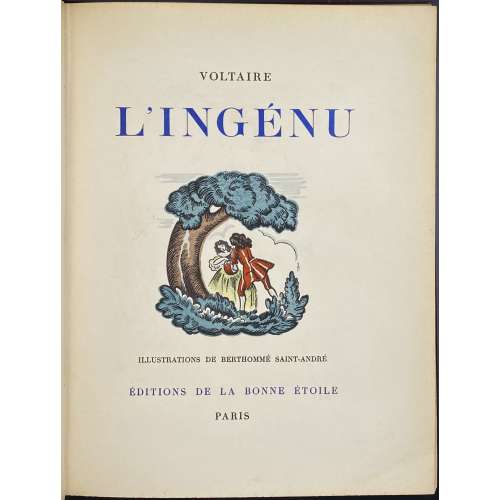 Description: One volume, 27 x 21.5 cm, collated 4to, bound in full dark crimson calf with gilt floral border, raised bands with gilt filets, gilt lettering to spine, 16 colour plates, one of them loose, and numerous woodcut tailpieces. Title-page: (black and blue): VOLTAIRE | L'INGÉNU | {VIGNETTE} | ILLUSTRATIONS DE BERTHOMMÉ SAINT-ANDRÉ | ÉDITIONS DE LA BONNE ÉTOILE | PARIS || Collation: 4to; π4 (2 blanks, h.t./limitation, t.p.), 1-184, last blank; total 76 leaves plus 16 colour plates after Louis Berthommé Saint-André and two flyleaves, first and last. Pagination: [4 blanks] [1-4] 5-143 [144] [4 blanks]; total 152 pages, ils. Limitation: Edition limited to 2,500 copies, of which this is copy № 1621. Colophon: Printed under direction of Paul Cotinaud at L’Union Typographique by Henri Leduc; photogravures executed by G. Duval and coloured by E. Vairel fils. Contributors: François Marie Arouet de Voltaire (French, 1694 – 1778) – author. Louis Berthomme Saint-André (French, 1905 – 1977) – artist.
Description: One volume, 27 x 21.5 cm, collated 4to, bound in full dark crimson calf with gilt floral border, raised bands with gilt filets, gilt lettering to spine, 16 colour plates, one of them loose, and numerous woodcut tailpieces. Title-page: (black and blue): VOLTAIRE | L'INGÉNU | {VIGNETTE} | ILLUSTRATIONS DE BERTHOMMÉ SAINT-ANDRÉ | ÉDITIONS DE LA BONNE ÉTOILE | PARIS || Collation: 4to; π4 (2 blanks, h.t./limitation, t.p.), 1-184, last blank; total 76 leaves plus 16 colour plates after Louis Berthommé Saint-André and two flyleaves, first and last. Pagination: [4 blanks] [1-4] 5-143 [144] [4 blanks]; total 152 pages, ils. Limitation: Edition limited to 2,500 copies, of which this is copy № 1621. Colophon: Printed under direction of Paul Cotinaud at L’Union Typographique by Henri Leduc; photogravures executed by G. Duval and coloured by E. Vairel fils. Contributors: François Marie Arouet de Voltaire (French, 1694 – 1778) – author. Louis Berthomme Saint-André (French, 1905 – 1977) – artist. -
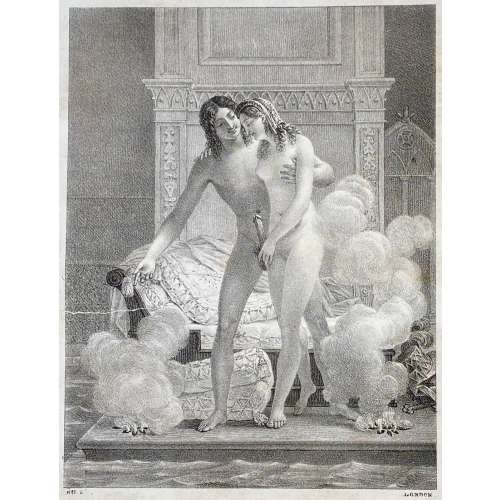 Description: Two volumes in one, collated 4to, 32.5 x 25.3 cm, bound in 19th-century long-grain green shagreen, flapped portfolio with a bronze lock clasp, gilt centrepiece fleuron, gilt- and blind-tooled boards and spine, spine with false raised bands, gilt-lettered "ESSAI | SUR LA MORALE"; text printed on bluish laid paper, blue marbled pastedowns; h.t. and t.p. in both volumes present. Restoration and conservation by Zukor art conservation in September 2022. Title-page: LA PUCELLE | D'ORLÉANS, | POËME EN VINGT-UN CHANTS. | Par VOLTAIRE | Édition ornée de Figures gravées par les meilleurs | Artistes de Paris. | — | TOME PREMIER (TOME SECOND). | — | A PARIS, | DE L’IMPRIMERIE DE DIDOT LE JEUNE. | L’AN TROISIÈME. || Imprint: A PARIS, | Chez les Frères Jacquenod, rue de Condé, no. 15. | A LYON, chez les mêmes. || Collation: Vol. 1: A-Z4, 2A-2H4 2I2; total 126 leaves; Vol. 2: A-Z4, 2A4 2B2, 2C-D4, 2E3 2F-2N4; total 141 leaves; first and last blank, plus 21 plates extraneous to collation, 8 in the 1st volume (incl. frontispiece) and 13 in the 2nd. Pagination: Vol. 1: [1-5] 6-251 [252], total 252 pages, ils; Note: leave 2A1 has a loss of 1/6 of the top, leave 2A2 torn out completely; Vol. 2: [1-5] 6-212, 2[211] 2212 [213] 214-279 [280], duplication of numbers 211 and 212 => total 282 pages, ils. The total number of pages in the volume is 534; one page torn out (187/8 in Vol. 1) Catalogue raisonné: Nordmann (2): № 562, p. 278; Cohen-deRicci: 1034. According to Nordmann (Christie’s), it was an edition illustrated with 21 plates after Lebarbier, Marillier, Monnet and Monsiau produced by various engravers; in the 1840s those plates were replaced with 24 lithographs by Achille Devéria, who signed them “LONDON”. In Nordmann’s copy, there is also a set of hand-coloured lithographs. There are only 21 plates in our copy, lacking three as per the source. Contributors : François Marie Arouet de Voltaire (French, 1694 – 1778) – author. Achille Devéria (French, 1800 – 1857) – artist. Pierre-Nicolas-Firmin Didot [Didot le Jeune] (French, 1769 – 1836) – publisher.
Description: Two volumes in one, collated 4to, 32.5 x 25.3 cm, bound in 19th-century long-grain green shagreen, flapped portfolio with a bronze lock clasp, gilt centrepiece fleuron, gilt- and blind-tooled boards and spine, spine with false raised bands, gilt-lettered "ESSAI | SUR LA MORALE"; text printed on bluish laid paper, blue marbled pastedowns; h.t. and t.p. in both volumes present. Restoration and conservation by Zukor art conservation in September 2022. Title-page: LA PUCELLE | D'ORLÉANS, | POËME EN VINGT-UN CHANTS. | Par VOLTAIRE | Édition ornée de Figures gravées par les meilleurs | Artistes de Paris. | — | TOME PREMIER (TOME SECOND). | — | A PARIS, | DE L’IMPRIMERIE DE DIDOT LE JEUNE. | L’AN TROISIÈME. || Imprint: A PARIS, | Chez les Frères Jacquenod, rue de Condé, no. 15. | A LYON, chez les mêmes. || Collation: Vol. 1: A-Z4, 2A-2H4 2I2; total 126 leaves; Vol. 2: A-Z4, 2A4 2B2, 2C-D4, 2E3 2F-2N4; total 141 leaves; first and last blank, plus 21 plates extraneous to collation, 8 in the 1st volume (incl. frontispiece) and 13 in the 2nd. Pagination: Vol. 1: [1-5] 6-251 [252], total 252 pages, ils; Note: leave 2A1 has a loss of 1/6 of the top, leave 2A2 torn out completely; Vol. 2: [1-5] 6-212, 2[211] 2212 [213] 214-279 [280], duplication of numbers 211 and 212 => total 282 pages, ils. The total number of pages in the volume is 534; one page torn out (187/8 in Vol. 1) Catalogue raisonné: Nordmann (2): № 562, p. 278; Cohen-deRicci: 1034. According to Nordmann (Christie’s), it was an edition illustrated with 21 plates after Lebarbier, Marillier, Monnet and Monsiau produced by various engravers; in the 1840s those plates were replaced with 24 lithographs by Achille Devéria, who signed them “LONDON”. In Nordmann’s copy, there is also a set of hand-coloured lithographs. There are only 21 plates in our copy, lacking three as per the source. Contributors : François Marie Arouet de Voltaire (French, 1694 – 1778) – author. Achille Devéria (French, 1800 – 1857) – artist. Pierre-Nicolas-Firmin Didot [Didot le Jeune] (French, 1769 – 1836) – publisher.


